Recently we did a review of the Advantech MIC-730AI NVIDIA Jetson AGX Xavier AI edge appliance. During that, we saw some really interesting machines from the company in an adjacent space. Specifically, Advantech has edge computing devices for 5G carriers that were announced as part of the Intel Xeon “Ice Lake” edition launch. The company currently has several 2nd Generation Intel Xeon Scalable products in this space as well that we have not covered on STH, so we thought we would highlight four of those specifically since the Ice Lake parts are about a quarter away from release. Many server vendors would consider these simply their edge products, but Advantech has a large portfolio of systems that are designed for IoT and the industrial edge so these are higher-end servers.
Advantech 5G Edge Carrier Server Solutions
These servers are being designed for the ORAN and similar 5G edge markets. A big shift happened recently. Carriers decided that they would get behind an effort to utilize “white box” gear in 5G networks. Instead of expensive carrier products, the focus would be on leveraging more commodity hardware. As a result of this shift, a number of vendors have been targeting the space including Advantech.
Here are the four current-gen 5G Edge carrier servers that we are going to cover today:
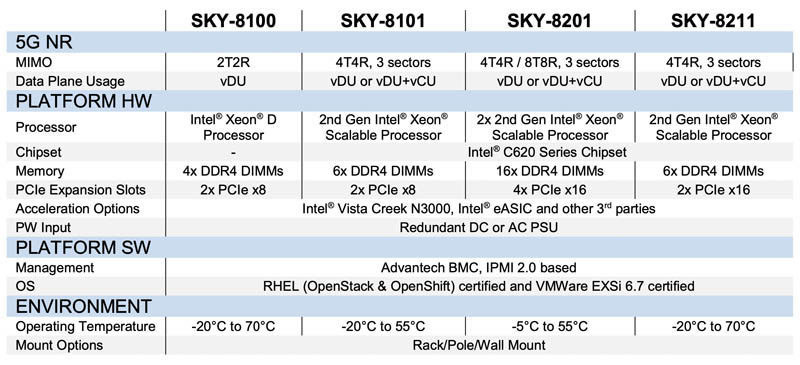
Something very interesting in this table is that Advantech solution specifically calls out Intel FPGA Programmable Acceleration Card N3000 for Networking (Vista Creek) and also Intel eASIC solutions. This is one of the first server lines we have seen specifically marketed with eASIC.
The first server is the Advantech SKY-8100. This is a short-depth server at under 434mm/ 19.5″ that is based on the Intel Xeon D. There are a few different D-1500 SKUs available here. We have done a number of reviews on Xeon D-1500 short-depth servers from other vendors, but this is one of the only ones that includes redundant power supplies in this shallow of a chassis. Advantech also has dual 10GbE, quad 1GbE as well as two expansion slots and front/ rear management ports.
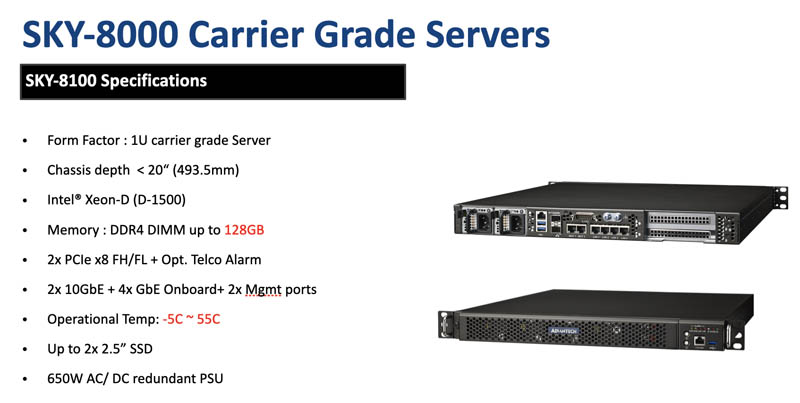
Going a bit bigger, the Advantech SKY-8101 is 508mm deep or around 20″. This uses a single Intel Xeon Scalable (Cascade Lake) processor. SSomething that is really interesting here is that there are fewer onboard network ports with dual 10GbE and dual 1GbE but this has more slots, up to four total, for expansion.
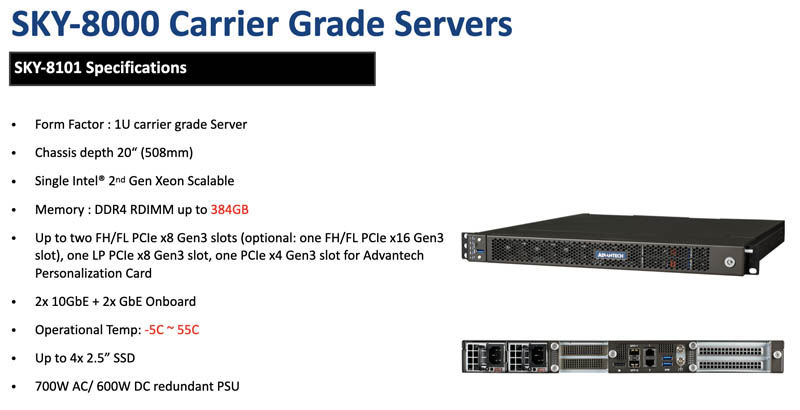
Moving to a 2U chassis allows the Advantech SKY-8102 to fit dual Xeons in the same 508mm/ 20″ depth. One also gets up to eight expansion slots in this configuration.
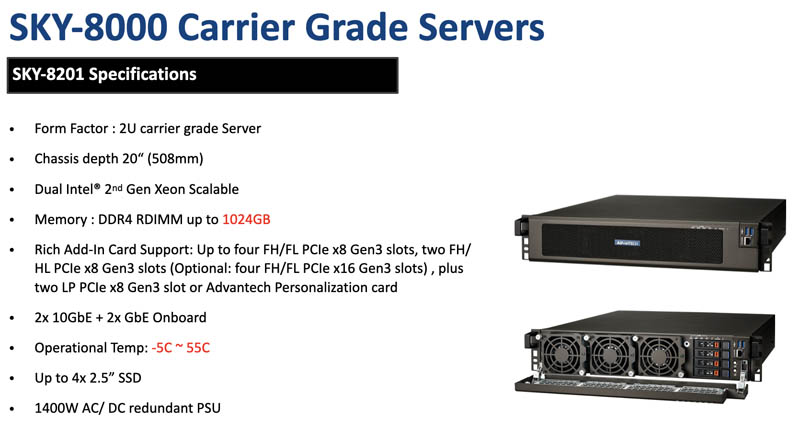
Then comes perhaps the “coolest” looking server. Advantech has a 2U single socket Cascade Lake server. This is only 430mm or 17″ deep but the top portion of the server comes with several option for networking. One can have 24+ networking ports on the top U of space.
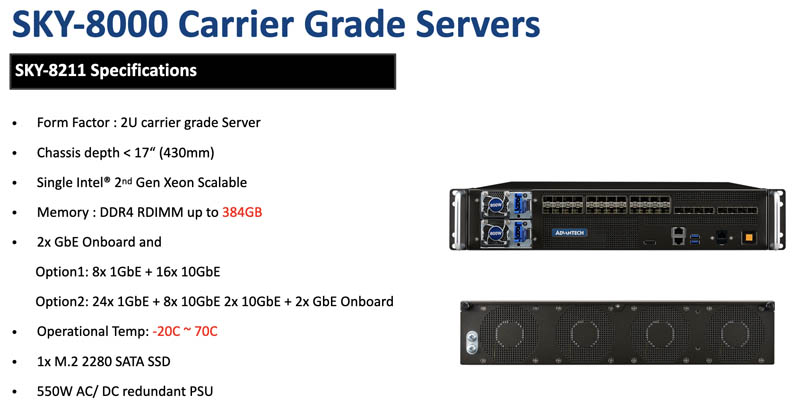
Overall, these are some pretty unique configurations. We know many of our readers work with short-depth spaces for equipment so when we found these we wanted to share them as there are some fairly unique solutions.
Final Words
We were told that these system are shipping but that the next-gen carrier-grade Ice Lake systems will ship in the Q4 timeframe. Still, we know that STH has many readers that work with telco gear and are planning O-RAN/ vRAN. We also have folks that like to use this gear in other applications so we thought it would be fun to show.
Let us know if you want to see reviews of these systems in the future on STH.

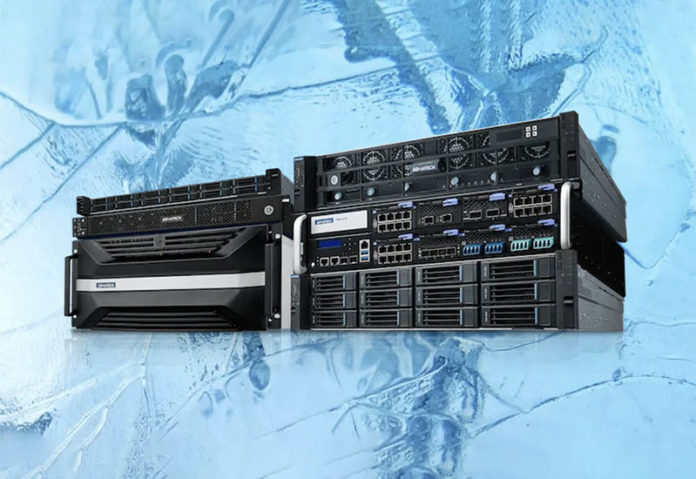



Thanks guys. That shifty typo has been fixed.
I don’t see a pressing need for 5G/telecom reviews. It’s cool hardware and reviews would be a fun read, but all things being equal I’d rather have more switch teardowns, high-end racks and processor reviews than carrier stuff.
Similar to how the Atom x6xxx chips would be fun to have a review on, I’d rather see server/workstation and exotic or AI silicon reviewed.
Do a video and the xeond d or the 8211
An Atom P5900 or x/n/j 6000 series Elkhart Lake Review would be great. Especially those low level benchmarks like spec in ST and MT.
This is intels future architecture that we are going to see more and more in client next year and will arrive in the server space with granite rapids in 2023-2024.
The big Cove cores with large OoO windows and µop caches have been hitting a wall recently, with bad PPA overall, high power and lower performance compared to their smaller AMD cousins.
So the monts are supposed to be Intels power and area optimized architecture and it would be interesting to see how they stack up, considering that tremont already has the big changes that predates future Gracemont improvements (I heard gracemont is mainly focused on higher clockspeeds and better floating point instruction support).
They really scaled the architecture quite a lot already with tremint, even having a 6wide decoder, bigger than even icelake, tigerlake and sapphire rapids.
Just to be sure I’m clear: on the SKY-8000; are all the network ports ‘true’ NICs visible to the OS running on the server as normal network interfaces; or is it, internally, more like some of the blade chassis arrangements where the compute node has a (typically quite fast and conveniently cable free) connection to the externally visible network ports; but those ports are actually hanging off a switch integrated into the chassis, rather than off the compute node itself?
Or is it some hybrid of the two, with switch-style ASICs allowing for very high speed traffic between the NICs without the host CPU having to do all the shoveling itself; but with configuration of the ‘switch’ component directly exposed to the host computer rather than being handled indirectly through a switch OS/firmware running on a little management processor?
I have to admit that I don’t really have a good sense of how much switch a contemporary Xeon could do in software before bottlenecking things; or how much a contemporary NIC(presumably with DMA and a fair amount of offload) would actually require the host CPU to do when the workload just involves sending traffic from one NIC on the PCIe bus to another NIC on the same bus.
OK, what is the exact purpose of these servers?
We all read that telcos want to do more O-RAN stuff to save money but this looks more like replacement for 2G/3G equipment than something a telco would promote as fast 5G.
4T4R seems very low end for mid-band 5G. Even 8T8R is nothing to brag about.
I read a little on what advantech and other companies like ADLink with their MEC server are doing with these:
These are not necessarily for “carriers”. A big share of these servers is going to private and industrial networks.
In many european countries dedicated parts of the spectrum are locally allocated to big companies. Japan and the US have plans to do similar stuff in the future.